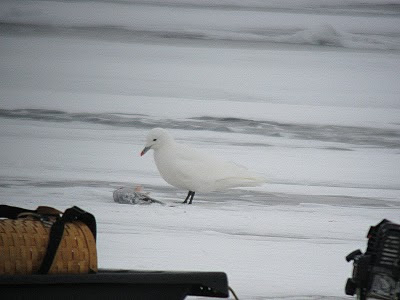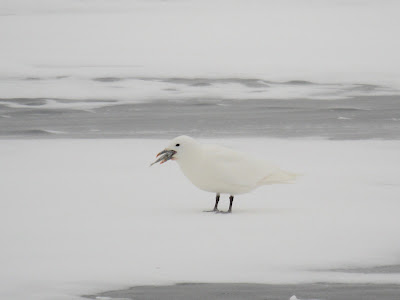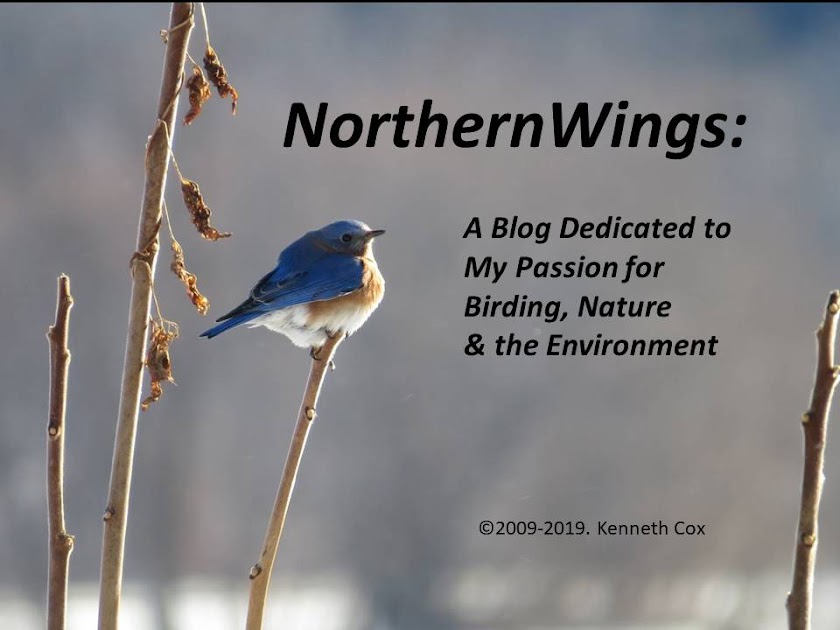022110.jpg) Monday, February 22, 2010. As we near the end of winter I believe the general opinion of most Vermont birders is the season has so far been anything but remarkable save the two Northern Hawk-Owls in Ferdinand and Derby. However, last Friday's discovery of an adult Ivory Gull on northern Lake Champlain appears to have caused a long awaited stir on both sides of the Vermont-New York border. The gull was first sighted by Pat Jones near the east end of the Route 2 Bridge between Alburgh, VT and Rouses Point, New York.
Monday, February 22, 2010. As we near the end of winter I believe the general opinion of most Vermont birders is the season has so far been anything but remarkable save the two Northern Hawk-Owls in Ferdinand and Derby. However, last Friday's discovery of an adult Ivory Gull on northern Lake Champlain appears to have caused a long awaited stir on both sides of the Vermont-New York border. The gull was first sighted by Pat Jones near the east end of the Route 2 Bridge between Alburgh, VT and Rouses Point, New York.According to the VTBIRD listerserve Saturday postings reported the bird to be frequenting Kelly Bay in VT just south of the bridge where it was scavenging on fish caught and discarded by ice fishermen. I was unable to get up there until Sunday morning and by that time it had moved to the NY side of the lake north of the break
022110.jpg) water at the terminus of Stony Brook Road and south of Rouses Point. Upon my arrival several birders, including Bryan Pfeiffer, were there enjoying views of the gull. It was then standing at at the edge of the ice sheet several 100 yards from the viewing spot where it remained for nearly an hour. As word was getting out via listserves, twitters, etc. a steady stream of anxious birders was developing for a glimpse and/or photograph of this rarity from above the Arctic Circle.
water at the terminus of Stony Brook Road and south of Rouses Point. Upon my arrival several birders, including Bryan Pfeiffer, were there enjoying views of the gull. It was then standing at at the edge of the ice sheet several 100 yards from the viewing spot where it remained for nearly an hour. As word was getting out via listserves, twitters, etc. a steady stream of anxious birders was developing for a glimpse and/or photograph of this rarity from above the Arctic Circle.Like Kelly Bay the Rouses Point location is popular with ice fishermen and where there are fishermen a gull might expect to find its next meal and so it did. Spotting a large Chain Pickerel on the ice the gull flew over and settled among the ice fishing activity and approaching birders. A nearby Yellow Perch enventually redirected its attention and was promptly gulped down (photos below).
This is the second Ivory Gull, both adult birds, I have seen. The first was just last winter at Plymouth, Massachusetts. I am struck by the intense whiteness of the adult birds and when on a snowy background how easily it would disappear if not for its jet black eyes and legs. In flight adult Ivory Gulls are almost ghostly.
According to my copy of Birdwatching in Vermont (Murin and Pfeiffer 2002) this is the fifth record of Ivory Gull in VT, all from the Lake Champlain area. The two earliest records, April 1982 and March 1983, are considered "hypothetical" sightings by the Vermont Bird records Committee given the lack of confirming identification evidence. The other two records are from January and November 2000 and were first winter and first summer birds, respectively.
Even though the appearance of such a rarity wherever one may show up south of Canada is cause for much excitement within the birding community, the recent occurrences of Ivory Gulls well outside their normal winter range raises suspicions that all may not be as it should be. Far flung vagrants this winter include an Ivory Gull at Cape May, New Jersey (November-December 2009) and an astounding sighting at West Point, Georgia in January of this year. Ivory Gulls not unlike Polar Bears to which it is often associated is an animal of the Arctic ice pack. It is dependent on the interface of sea ice and open water for the fish it feeds on and to some extent the remains of seal carcasses left after Polar Bear kills.
Current IUCN conservation status of Ivory Gull is near threatened, while the Canadian population has been designated endangered. There the number of breeding birds has been reported to have declined 80% since the early 1980s. This has fostered speculation that the species may be nearing the brink of extinction. Scientists who study Ivory Gulls are more guarded in their prognostications since so little is known of populations throughout the species range and factors that may influence them. That said, Ivory Gulls have been found to have some of the highest levels of contaminants in their body tissues and are experiencing habitat loss as a result of the shrinking ice shield assigned to global climate change. Other threats include disturbance of nesting birds from human activities and predation.
So as I admired the gull through through the scope and snapped off photos I could not help wonder what the future of this particular gull was or more importantly its species. Will it become another species to go extinct during my lifetime as a result of human kind's impacts on the natural environment or will it manage to adapt somehow? I suppose time will tell but this is little consolation as we continue to rapidly change Earth's environment and all its life faces an uncertain future.
022110.jpg) 1. Gull finds a 5-6 inch Yellow Perch discarded on ice.
1. Gull finds a 5-6 inch Yellow Perch discarded on ice.022110.jpg)
2. With a little toss in the air, the gull positions the fish head first into its mouth.
022110.jpg)
3. And now, the fish is about to be swallowed whole spiny fins and all.
Information sources:
COSEWIC (Committee on the Status of Endangered Wildlife in Canada). 2006. Assessment and update status report on the ivory gull Pagophila eburnea in Canada. www.sararegistry.gc.ca/virtual_sara/files/cosewic/sr_ivory_gull_e.pdf.
Gilchrist, H. G., and M. L. Mallory. 2005. Declines in abundance and distribution of the ivory gull (Pagophila eburnea) in Arctic Canada. Biological Conservation 121(2):303-309.
IUCN (International Union for Conservation of Nature). Ivory gull (Pagophila eburnea). www.iucnredlist.org/apps/redlist/details/144228/0.
020710.jpg)